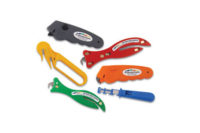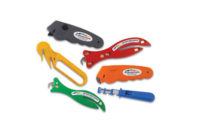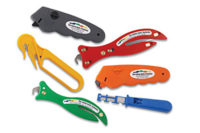Safety knives

Photo: Pacific Handy Cutter
Years ago, the grocery industry, in particular, found a type of handy little knife to be very useful when opening tens of thousands of box tops every day. However, along with providing a quick and easy way to open cartons came a propensity for accidents. Eventually this handy little tool earned a nickname, “The Suicide Cutter,” as the most common accident was to slip off of a box and cut one’s opposite arm or wrist. This, combined with costly damage to merchandise like cereal boxes, cake mixes, etc., led to the need for a whole new generation of cutting tools.
In the past 20 years, safety cutters have evolved to provide a safer work environment for nearly any industry. They fall into one of four basic categories: Guarded Safety Cutters, Spring-Back Cutters, Hooded Cutters or Hook Knives.
Four types of safeguards
Guarded Safety Cutters come in both right and left-handed models. The guard acts as an angled cutting guide while also concealing the blade to protect the user from accidental contact. This is the preferred safety cutter for removing the tops of boxes and is proven to reduce both accidents and damaged merchandise. This style of cutter usually comes with blunted tip blades, blade storage, a tape splitter and an ergonomic handle to help reduce repetitive motion injuries. More large retailers use this type of safety cutter than any other.Spring-Back — self-retracting — Safety Cutters are probably the second-most commonly used. The number-one feature of this type of cutter is that the blade cannot be left in an exposed position when not in use. If used properly, a self-retracting cutter can greatly reduce the potential for accidental injury. Most require you to start your cut and then remove your thumb from the blade operation button. The friction of the blade being pulled through the cardboard keeps the blade extended until contact with the work surface is finished and the blade retracts.
Unfortunately, this safety feature can be overridden if the user keeps his or her thumb on the operation button, and thus keeps the blade in an exposed position. Often, spring-back cutters also feature blunted tip blades, blade storage and ergonomic handle designs. They are used primarily in hardware, industrial and warehouse settings.
Hooded Safety Cutters offer another solution to the problem of accidental cuts in the workplace. Essentially this type of cutter comes one step closer to taking human error out of the equation. Available in low-cost disposable and non-disposable varieties, they usually have one or more release points that allow the hood to rotate or retract back, exposing the blade to the cutting surface. When removed from the cutting surface, the hood snaps back over the blade.
Higher-end models provide ambidextrous release buttons and a hood that springs back and locks over the blade.
Disposable safety cutters are primarily used in the restaurant and quick-serve industries where replaceable blades are frowned on, as there is the possibility of a blade falling into food preparations. Most offer blunted tip blades, tape splitters and an ergonomic handle design.
Hook Knives are the last category of safety knives. They come in a variety of shapes and sizes. They can be used for everything from opening shrink-wrap around pallets to removing plastic banding from bundled merchandise. They are available in both disposable and non-disposable models, depending on the work environment.
This type of safety cutter offers the greatest protection to the user as the razor blade is usually concealed within the hooked opening which is not wide enough to allow access to one’s finger, hand or other extremities.
Getting employees over the hurdle
As with any application, albeit beneficial or cost-effective, getting employees over the “resistance to change” factor is always a hurdle. Too many times, they opt for what they are used to using, even if it means putting themselves and others at risk. This is where training and employer involvement becomes integral.Once they are properly trained and/or management mandates the use of a safer tool, employees quickly adapt to the idea and it becomes second nature to them. Worker productivity is increased and there is less cutter turnover, as most safety cutters are designed for work applications and do not lend themselves to average home use.
We’ve come a long way since “The Suicide Cutter” was introduced more than 50 years ago. With employee and management input, safety cutters have become the industry standard, whether they are used in grocery, hardware/industrial or foodservice areas. Employees are working safer and management is seeing less workers’ compensation claims and less damage to expensive merchandise — just by making a commitment to safety and using the right tool for the job.
Looking for a reprint of this article?
From high-res PDFs to custom plaques, order your copy today!







